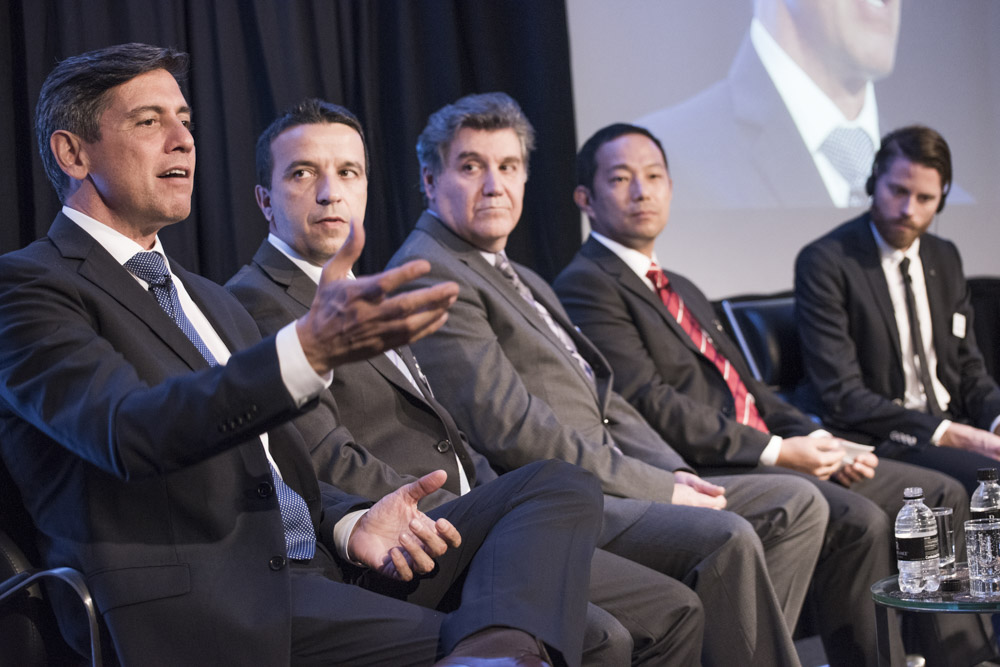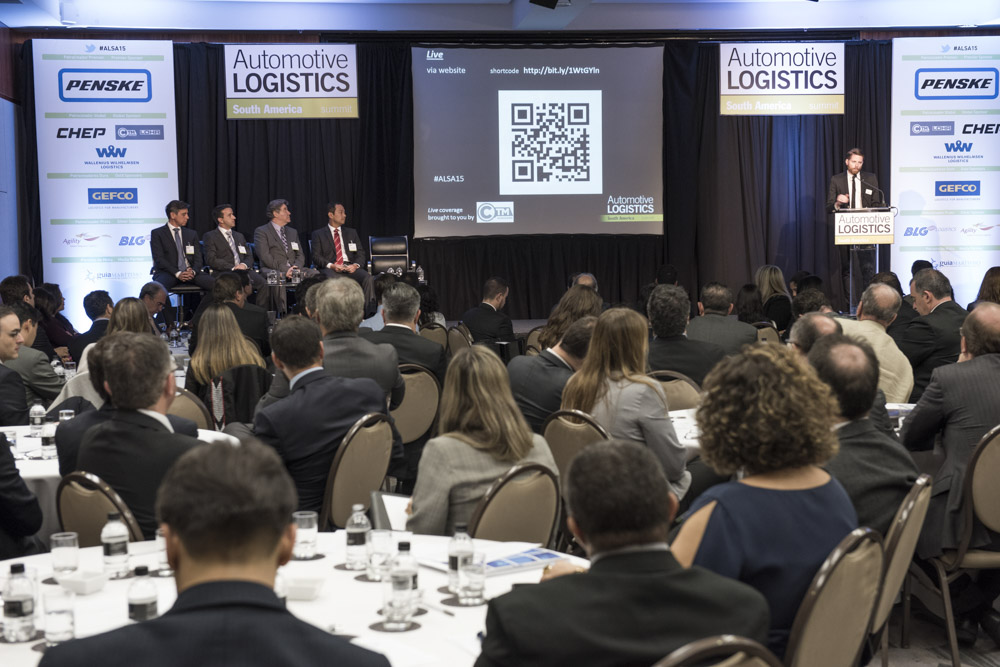
Facing further declines and difficulties, OEM executives talk about their plans to survive the ongoing Brazilian storm
For the Brazilian automotive industry, 2015 has been bad, and next year is expected to be even worse. However, despite the sharp declines and pessimism, executives are optimistic that things will eventually get better. Until this happens, OEMs, suppliers and LSPs are reorganising themselves, trying to save money, and putting plans in place to survive the storm. In the final session at Automotive Logistics South America 2015, OEM executives discussed both high level topics, including changes, collaboration, and creativity, along with more specific details, including the conundrum between price versus cost cutting, outsourcing to LSPs in a difficult market, and how the network in South America is often bigger than just Brazil.
The panel featured (left to right): Neuton Karassawa, logistics director, General Motors; Antonio Taranto, customer service operations director, South America, Ford; Fabio Castello, vice president logistics, Scania Latin America; and Orlando Moral, operations director, Chery Brasil.

…on the potential for collaboration
 Karassawa, General Motors: In Brazil we have Anfavea (the Brazilian OEM association), which facilitates discussion between OEMs. Carmakers can discuss things of common interest such as container transportation: there are currently limitations for 40ft containers and we have to pay 11,000Real to move a load like that. That’s just an example, but the group allows us many opportunities, and adds value to the whole market. In a challenging market we need to be more creative, and we need to encourage other practices such as that.
Karassawa, General Motors: In Brazil we have Anfavea (the Brazilian OEM association), which facilitates discussion between OEMs. Carmakers can discuss things of common interest such as container transportation: there are currently limitations for 40ft containers and we have to pay 11,000Real to move a load like that. That’s just an example, but the group allows us many opportunities, and adds value to the whole market. In a challenging market we need to be more creative, and we need to encourage other practices such as that.
 Taranto, Ford: We collaborate on the distribution of parts and how these parts arrive at our clients. We have great partnerships in Anfavea, where we deal with subjects that are in the interests of everyone. We do have room for improvement though.
Taranto, Ford: We collaborate on the distribution of parts and how these parts arrive at our clients. We have great partnerships in Anfavea, where we deal with subjects that are in the interests of everyone. We do have room for improvement though.
We are currently launching a new distribution centre with Penske in Gravati, in the south of Brazil, where GM also has a plant. Could we work together? Also, we need to think outside the box. Ford has 550 distributors spread over Brazil, and we have four distribution centres. Why not use some of our distributors as distribution centres to get closer to the market?
 Castello, Scania: What Neuton Karassawa said it extremely important as it refers to legal aspects, regulatory aspects, and national standards. Anfavea has an important role and joins together the interests of all OEMs, and clearly shows what the gains would be for OEMs in facilitating some standards.
Castello, Scania: What Neuton Karassawa said it extremely important as it refers to legal aspects, regulatory aspects, and national standards. Anfavea has an important role and joins together the interests of all OEMs, and clearly shows what the gains would be for OEMs in facilitating some standards.
When we talk about collaboration in logistics flows I’m a bit more skeptical. OEMs have methods that are quite different, and internal standards that are different. Logistics operators can identify possibilities and bring them to OEMs, if that translates into savings for both parties. At Scania, we talk about collaborating, and many times there are gains within OEMs, such as connecting inbound with outbound, and planning transportation – you can find many opportunities in-house. The synergies are there. It doesn’t have to be complicated. You just need initiative and to connect the flows within companies.
 Moral, Chery: I agree with my colleagues. There are a number of regulations and rules that we have in Brazil and sometimes they get in the way and don’t make sense. Synergies on routes can work: we were talking about an OEM that made an agreement to take back some parts of another OEM. There is a lot of room for improvement within organisations themselves. Logistics could bring savings, and logistics can show companies that they are making money for them. You can make more money with logistics than several products in Brazil.
Moral, Chery: I agree with my colleagues. There are a number of regulations and rules that we have in Brazil and sometimes they get in the way and don’t make sense. Synergies on routes can work: we were talking about an OEM that made an agreement to take back some parts of another OEM. There is a lot of room for improvement within organisations themselves. Logistics could bring savings, and logistics can show companies that they are making money for them. You can make more money with logistics than several products in Brazil.

Karassawa, General Motors: As OEMs, our DNA is to put cars together. Logistics is a cost centre. During times of crisis, when we can’t increase revenues, to maintain the company you have to be more efficient, and do the same with less. As logistics professionals, be it OEMs or LSPs, we have a tremendous opportunity to give our contribution, and maybe even more so in an uncomfortable situation. The idea in the draw that was supposed to be crazy is not as crazy any more.

Taranto, Ford: We can’t lose money and we have to take all the opportunities presented to us. I’m in the post-sales and client satisfaction end of the business. When a part or assembly line stops, and we have problems, we have to do our own laundry. When there’s a lack of parts for a client, they take it straight to the newspapers and media. The client should always be the central focus. It’s important to be more competitive, have a high level of quality, deliver at the right time, maximise efforts, have no damages, and having a satisfied client.
 Castello, Scania: The fact of being here for me is already collaboration. The ideas that come up at the coffee breaks, or the think tanks, or the presentations by OEMs or LSPs are enough to create new ideas and new products. These initiatives, like others that happen in our country, are worthy of attention. The exchange of ideas is good, even though we have companies here that are competitors. The Brazilian manufacturing industry should be more competitive.
Castello, Scania: The fact of being here for me is already collaboration. The ideas that come up at the coffee breaks, or the think tanks, or the presentations by OEMs or LSPs are enough to create new ideas and new products. These initiatives, like others that happen in our country, are worthy of attention. The exchange of ideas is good, even though we have companies here that are competitors. The Brazilian manufacturing industry should be more competitive.
…on saving costs versus cutting prices and rates and logistics providers

Moral, Chery: My view is that opportunities for changes and ideas and implementation of cost-saving ideas are practically infinite. We take logistics and see how it has evolved and how its reach has evolved within companies. In the past, logistics was limited to bring parts to the line, and then taking them to the place that was close to the line. In Europe, I worked on a project with some consulting companies and we managed to get savings of 15-20% by investing in a project we changed the logistics concept of the plant to remove waste. Parts would arrive in high frequencies with no space. There were no parts at the line itself, and every 15 minutes we would have small quantities arriving, and everything was in reach. This brought us huge gains. The opportunities in this field are fantastic. Ideas can be adapted to the domestic context. It’s simple to use these ideas and logistics can contribute to the whole business.

Karassawa, General Motors: We have a timeline in three parts: short, medium and long. In the short-term, we work on commercial initiatives and react to what is happening at the time. In the medium-term, we need to increase productivity and redesign the network. In some situations you have to do a redesign, localise parts suppliers, but you need help from operators. They are part of the solution and the problem. It’s not simple to implement these ideas, and each one has to have a return, but we do have a goal in behavior to think long-term and think about a healthy change. It’s not feasible for the operator if you don’t have a lot of competition, or healthy competition that the market requires.
 Taranto, Ford: We’ve gone through about 10-13 crises in the market. What we’re sure of is that this will recover, but we might also be sure that it will drop again. We have to have a partner that’s very reliable and a partner that works with transparency and a long-term partnership. It’s difficult to find a win-win today, it’s currently who loses less. The opportunity in the future is that we’ll be able to recover. As for transparency, that’s fundamental.
Taranto, Ford: We’ve gone through about 10-13 crises in the market. What we’re sure of is that this will recover, but we might also be sure that it will drop again. We have to have a partner that’s very reliable and a partner that works with transparency and a long-term partnership. It’s difficult to find a win-win today, it’s currently who loses less. The opportunity in the future is that we’ll be able to recover. As for transparency, that’s fundamental.
…on the flexibility of LSPs

Karassawa, General Motors: This year in particular, everyone was caught unawares for what we were expecting. At the end of last year, and in the months following, we just saw everything going down. GM with its chain of suppliers and parts are flexible, but a scenario such as this one needs more extreme measures. Coming from a history during the past few years of continuous growth… if you do an analogy, it’s like the sports guy who is not used to a strong adversary. Not only do we have to adjust, the situation demands big actions including restructuring and reorganising. This current moment needs a degree of flexibility that the market wasn’t prepared for. We need to be capable. Next year will be harder than this one. We simply cannot do more of the same. We need to increase collaboration, build solid relationships, lose less, win more. The big challenge today is not to allow this pessimism to take over our organisations, otherwise people will be frozen when they no longer have the capacity to act. The leadership challenge is to be a change agent during such a delicate time as this.
 Taranto, Ford: What makes me happy when talking about the market is the creativity of the Brazilian people and companies. I believe a lot in creativity: we are flexible, we are quick. We can’t lose the people that have developed. If you are able to retain talent, and be prepared, the acceleration of recovery is much quicker. This makes me happy. It’s the flexibility, and aggressiveness throughout all segments that makes me happy.
Taranto, Ford: What makes me happy when talking about the market is the creativity of the Brazilian people and companies. I believe a lot in creativity: we are flexible, we are quick. We can’t lose the people that have developed. If you are able to retain talent, and be prepared, the acceleration of recovery is much quicker. This makes me happy. It’s the flexibility, and aggressiveness throughout all segments that makes me happy.

Castello, Scania: When the market is hot we have a large portfolio of orders. We know what materials we will need, and our suppliers are able to visualise and plan. But in a crisis situation, the portfolio of orders disappears. This makes planning production and forecast management more difficult. We work with statistical numbers, and seasonal numbers, to forecast the market we show you now. When companies have a low volume, that’s when more flexibility is needed. Tomorrow an order might come in that wasn’t forecast by anyone. You have to use creativity to make things happen.

Moral, Chery: What’s important is that logistics companies and providers are flexible. Obviously flexibility is limited but in a crisis situation, peaks can come. We have to have initiatives: for example, having our own fleet, or outsourcing the fleet, factors that allow you to be more or less flexible throughout these difficult moments. Really, it is a difficult time.
…on outsourcing and the relationship between OEMs and LSPs

Taranto, Ford: During the crisis it is a bit more difficult to generate business for our LSPs. The trend for the automotive industry is to outsource activities that we don’t believe are core activities where our logistics providers have more synergy and competency and productivity.

Castello, Scania: At the beginning of the year we transferred some more work to our external logistics providers. They worked exclusively for the inbound side, but because of the strategy and space we decided to transfer CKD packaging. Although there was a concern about the level of performance and quality of the CKD process, we worked with the operator in a nursing period. We put cameras with the operators and people at the plant. Each step of the process, and the knowledge, was transferred to our operator in a controlled manner. Quality levels are higher, with a learning process that is sufficient for them to do the best they can.

Karassawa, General Motors: When we talk about how to build and how to strengthen, we can think about horizontal cooperation, and vertical as well. Each tier one and tier tier, can benefit from expertise, and extend expertise to the chain. If your supplier has a better chain, there are benefits of this for all companies, including operators, and this is a side of the story that can be explored.

Moral, Chery: As an OEM, there are ‘n’ number of operations where you can partner with other companies. Expansion, the market, the launch of a new product, all these favour partnerships. I have no doubt that using an LSP currently is much more economical and works for both sides. There’s an aspect of flexibility.
…on working across markets in South America

Karassawa, General Motors: We have good examples of opportunities where we can use this regional leverage. I don’t think all the countries have a big enough scale to build across them though. Brazil and Argentina have several suppliers common to both countries. We have a system of collecting and milk runs – we do combined collections and also use this network that we have for overseas suppliers to build this in our region. In our solutions we are looking to have synergy, scale, and volume.
 Taranto, Ford: We have operations in all of South America, and we benefit from having global products that share the same parts. That means products produced and sold in Brazil, are then imported to Argentina and have the same number of parts. I am able to balance security stock throughout the whole of Latin America.
Taranto, Ford: We have operations in all of South America, and we benefit from having global products that share the same parts. That means products produced and sold in Brazil, are then imported to Argentina and have the same number of parts. I am able to balance security stock throughout the whole of Latin America.

Castello, Scania: In our route design we identified an opportunity to connect milk runs from the south of Brazil, with a flow of Argentinian suppliers, instead of connecting in Argentina. We will consolidate Argentinian materials, then bring it together and reduce the number of empty returns to Argentina.

Moral, Chery: We are working on two projects. The first is authorising vehicles produced here to be distributed to Argentina. The second project is to other Latin American countries. Sharing works in developing markets. Eventually we could have distribution for the whole of South America with transportation synergies and gains.
…on hopes for improvements from LSPs in 2016

Moral, Chery: The service is efficient but I would like you to reduce your prices. That’s what I expect from 2016.

Castello, Scania: It’s difficult to expect anything for next year. I receive criticism in our production plant as our vice-president of HR said, ‘five years ago we have five versions throughout the year, and now we have 75 versions of production planning’. I would like fewer versions of my production calendar.

Taranto, Ford: Use your creativity more because we need it.

Karassawa, General Motors: We have urgencies to resolve issues and problems. I suggest everything possible to work on, resolve, and solve problems. It makes a different. And plan. We can’t resolve everything but many things are in our influence circle.
Click here to read the report from this year's conference: Taking control in a crisis.
 Karassawa, General Motors: In Brazil we have Anfavea (the Brazilian OEM association), which facilitates discussion between OEMs. Carmakers can discuss things of common interest such as container transportation: there are currently limitations for 40ft containers and we have to pay 11,000Real to move a load like that. That’s just an example, but the group allows us many opportunities, and adds value to the whole market. In a challenging market we need to be more creative, and we need to encourage other practices such as that.
Karassawa, General Motors: In Brazil we have Anfavea (the Brazilian OEM association), which facilitates discussion between OEMs. Carmakers can discuss things of common interest such as container transportation: there are currently limitations for 40ft containers and we have to pay 11,000Real to move a load like that. That’s just an example, but the group allows us many opportunities, and adds value to the whole market. In a challenging market we need to be more creative, and we need to encourage other practices such as that. Taranto, Ford: We collaborate on the distribution of parts and how these parts arrive at our clients. We have great partnerships in Anfavea, where we deal with subjects that are in the interests of everyone. We do have room for improvement though.
Taranto, Ford: We collaborate on the distribution of parts and how these parts arrive at our clients. We have great partnerships in Anfavea, where we deal with subjects that are in the interests of everyone. We do have room for improvement though. Castello, Scania: What Neuton Karassawa said it extremely important as it refers to legal aspects, regulatory aspects, and national standards. Anfavea has an important role and joins together the interests of all OEMs, and clearly shows what the gains would be for OEMs in facilitating some standards.
Castello, Scania: What Neuton Karassawa said it extremely important as it refers to legal aspects, regulatory aspects, and national standards. Anfavea has an important role and joins together the interests of all OEMs, and clearly shows what the gains would be for OEMs in facilitating some standards. Moral, Chery: I agree with my colleagues. There are a number of regulations and rules that we have in Brazil and sometimes they get in the way and don’t make sense. Synergies on routes can work: we were talking about an OEM that made an agreement to take back some parts of another OEM. There is a lot of room for improvement within organisations themselves. Logistics could bring savings, and logistics can show companies that they are making money for them. You can make more money with logistics than several products in Brazil.
Moral, Chery: I agree with my colleagues. There are a number of regulations and rules that we have in Brazil and sometimes they get in the way and don’t make sense. Synergies on routes can work: we were talking about an OEM that made an agreement to take back some parts of another OEM. There is a lot of room for improvement within organisations themselves. Logistics could bring savings, and logistics can show companies that they are making money for them. You can make more money with logistics than several products in Brazil. Castello, Scania: The fact of being here for me is already collaboration. The ideas that come up at the coffee breaks, or the think tanks, or the presentations by OEMs or LSPs are enough to create new ideas and new products. These initiatives, like others that happen in our country, are worthy of attention. The exchange of ideas is good, even though we have companies here that are competitors. The Brazilian manufacturing industry should be more competitive.
Castello, Scania: The fact of being here for me is already collaboration. The ideas that come up at the coffee breaks, or the think tanks, or the presentations by OEMs or LSPs are enough to create new ideas and new products. These initiatives, like others that happen in our country, are worthy of attention. The exchange of ideas is good, even though we have companies here that are competitors. The Brazilian manufacturing industry should be more competitive. Taranto, Ford: We’ve gone through about 10-13 crises in the market. What we’re sure of is that this will recover, but we might also be sure that it will drop again. We have to have a partner that’s very reliable and a partner that works with transparency and a long-term partnership. It’s difficult to find a win-win today, it’s currently who loses less. The opportunity in the future is that we’ll be able to recover. As for transparency, that’s fundamental.
Taranto, Ford: We’ve gone through about 10-13 crises in the market. What we’re sure of is that this will recover, but we might also be sure that it will drop again. We have to have a partner that’s very reliable and a partner that works with transparency and a long-term partnership. It’s difficult to find a win-win today, it’s currently who loses less. The opportunity in the future is that we’ll be able to recover. As for transparency, that’s fundamental. Taranto, Ford: What makes me happy when talking about the market is the creativity of the Brazilian people and companies. I believe a lot in creativity: we are flexible, we are quick. We can’t lose the people that have developed. If you are able to retain talent, and be prepared, the acceleration of recovery is much quicker. This makes me happy. It’s the flexibility, and aggressiveness throughout all segments that makes me happy.
Taranto, Ford: What makes me happy when talking about the market is the creativity of the Brazilian people and companies. I believe a lot in creativity: we are flexible, we are quick. We can’t lose the people that have developed. If you are able to retain talent, and be prepared, the acceleration of recovery is much quicker. This makes me happy. It’s the flexibility, and aggressiveness throughout all segments that makes me happy. Taranto, Ford: We have operations in all of South America, and we benefit from having global products that share the same parts. That means products produced and sold in Brazil, are then imported to Argentina and have the same number of parts. I am able to balance security stock throughout the whole of Latin America.
Taranto, Ford: We have operations in all of South America, and we benefit from having global products that share the same parts. That means products produced and sold in Brazil, are then imported to Argentina and have the same number of parts. I am able to balance security stock throughout the whole of Latin America.




































